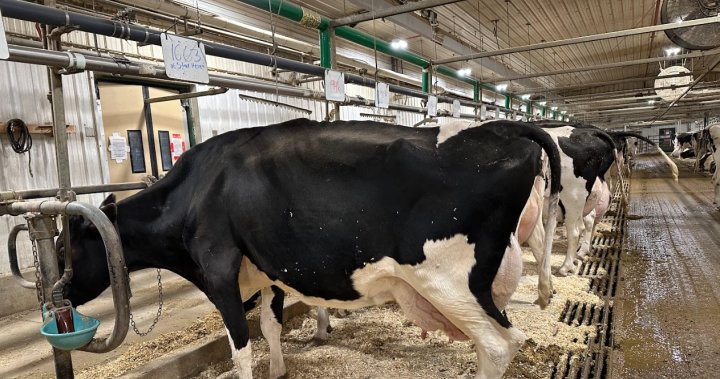Alberta startup using tech and AI to track dairy cow health | Globalnews.ca
Monitoring their herd could soon be a lot easier for dairy farmers in Canada, thanks to an Edmonton-based startup.
Innovation startup iClassifer is using images, videos and artificial intelligence to track dairy cows and flag any potential injuries.
“We are trying to find lameness and lameness indicators at an earlier stage,” mechanical engineering student Emran Hamzehnezhadabkenari said. “If you detect lameness at an earlier stage, some steps can be taken and … the animal can be treated.
“In our project we’re trying to use artificial intelligence and some signal processing, image processing, in order to track animals’ welfare,” he explained.
“In the case of this study, there’s a problem called lameness. When an animal is lame, they cannot walk properly, and based on that, they are limping … and they have pain.
“The reality is when they are lame, they produce less milk. Less milk means less productivity and it’s really a loss for the producer.”

iClassifier was started in 2021 to bring AI to the farming industry.
Its application can be used on a farmer’s phone or through the automated assessment machine — a customized stall equipped with special cameras and imaging equipment — and processed using a unique AI algorithm.
The technology will make animal health assessments more accessible, affordable and frequent, the team believes.
iClassifer is using AI to monitor dairy cow herd health.
Courtesy: Emran Hamzehnezhadabkenari
“With our method, you can do that more frequently and as fast as possible, because you capture some videos and by getting information from that image, from that video, you can have the information you need for your herd as fast as possible,” Hamzehnezhadabkenari said.
“When an animal is walking, there is (a lot of) information in that,” he explained. “AI can use all that information, pixel by pixel, which means that you can have a better assessment, which means that you can have more information about the herd and all this results in better monitoring.”

The traditional human-centred methods can be costly and sometimes inconsistent.
This image-based method is more objective and can be done as often as the producer desires without additional expenses.
“We thought if we could automate this practice, we could help farmers perform these assessments more frequently, and provide an accurate and objective result they can use to improve the longevity and productivity of their herds,” iClassifier CEO Reza Sabbagh said.
Manafiazar said not only do classified cows live longer and produce more milk, but they also yield a net profit of $350 more per cow per year compared with non-classified herds.

The technology looks for trends in the animals and screens for certain indicators that are predictors of lameness, like the cow slowing down.
As many as 25 different traits, including udder texture and depth, bone quality, height and rump angle, can be measured and interpreted for farmers.
“There are many indicators of lameness. One of them is arched back, which means that when the animal is walking, they’re showing some arch in their back. Another lameness indicator is … they are moving their head vertically more than usual, so it shows that the animal is in pain,” Hamzehnezhadabkenari said.
iClassifer is using AI to monitor dairy cow herd health.
Courtesy: Emran Hamzehnezhadabkenari
This image-based analysis is also less invasive and less disruptive, the team said. Catching injuries earlier means the cows aren’t in pain for long periods of time.
“Our goal is to increase profits for producers, save the planet through efficiency, and most importantly, take care of animal welfare and animal health,” said animal scientist and iClassifier co-founder Ghader Manafiazar, an assistant professor in the department of animal science and aquaculture at Dalhousie University.
“Down the road, we suspect there will be many new traits that this technology will be able to quickly adopt and define.”

iClassifier is being supported by a national not-for-profit organization called Mitacs. Hamzehnezhadabkenari is a Mitacs intern and will help input the data and test the technology. Mitacs also receives funding from Alberta Innovates.
“The preliminary results that we got, they show promising results that our analysis is working and we can extract all indicators that we want,” Hamzehnezhadabkenari said.
“In our phase, we’ve already collected data on the lame cows and healthy cows and … comparing their movement patterns.”
A pilot project is expected to start on a Canadian dairy farm by spring 2024.
The team also envisions expanding the technology to help with the health and welfare of other livestock, including horses, pigs and camels.

© 2023 Global News, a division of Corus Entertainment Inc.
For all the latest Technology News Click Here


